Numerical Simulation Study on the Energy Benefits and Environmental Impacts of BIPV Installation Configurations and Positions at the Street Canyon Scale
Abstract
1. Introduction
2. Methodology and Numerical Procedures
2.1. Heat Transfer in BIPV Systems with Different Installation Configurations
2.2. Governing Equations
2.3. Computational Domain and Boundary Conditions
2.4. Discretization Schemes and Computational Meshes
3. Model Validation
4. Results and Discussion
4.1. BIPV System Energy Benefits
4.1.1. Electricity Generation Revenue Analysis
4.1.2. Energy Saving Benefits Analysis
4.2. BIPV System Environmental Impacts
4.2.1. Flow Field Analysis
4.2.2. Temperature Field Analysis
4.2.3. Pollutant Dispersion Analysis
4.3. Quantitative Analysis of Buoyancy and Wind-Driven Effects
4.4. Street Canyon Ventilation Indicators
5. Limitations and Further Study
6. Summary and Conclusions
- Compared with facade-mounted PV systems, rooftop-mounted systems show clear advantages in power generation. Under all test conditions, the installation method with ventilated channel (Type 1) not only achieves the best power generation performance, but also provides the strongest thermal insulation, which lowers cooling demand and reduces overall power consumption.
- The introduction of PV panels changes street canyon ventilation due to the interaction between incoming horizontal flow and buoyant flow inside the canyon. When the incoming wind speed is lower than 2 m/s, the effect of thermal buoyancy within the street canyon is stronger than the inertial force of the incoming flow, and thus, the effect of thermal buoyancy on street canyon ventilation is more significant.
- The effect of PV installation on ventilation varies by position. Leeward facade PV achieves the greatest improvement, followed by windward facade, while rooftop PV shows the weakest impact. At 0.5 m/s, compared to the non-PV canyon, rooftop, leeward facade, and windward facade PV installations increase ventilation flow rates by 1.43 times, 3.02 times, and 2.09 times, respectively. When wind speed rises to 1 m/s, the enhancement factors decrease to 0.48 times, 1.21 times, and 0.82 times, reflecting the reduced dominance of thermal buoyancy effects at higher wind speeds.
- Rooftop PV has a small effect on the street canyon temperature, whereas the introduction of facade PV panels locally reduces pedestrian thermal comfort, particularly under low-wind conditions, but this negative effect is significantly alleviated with increasing wind speed.
- Pollutant concentration inside the canyon is strongly linked to ventilation capacity. At the same ambient wind speed, street canyons with PV systems have significantly lower pollutant levels than those without PV systems, especially if the PV panels are installed on the windward or leeward facades. At an ambient wind speed of 0.5 m/s, rooftop, leeward and windward facades PV reduced pollutant concentrations by 30.1%, 87.7%, and 85.9%, respectively.
- The pollutant-weighted air changes per hour (PACH) proposed in this study overcomes the limitations of traditional ACH in evaluating pollutant removal efficiency in complex flow regimes, offering a more accurate and mechanistically insightful metric for assessing urban microenvironmental ventilation performance; despite its higher computational complexity, it significantly enhances the assessment capability of urban microenvironment ventilation performance.
Author Contributions
Funding
Data Availability Statement
Conflicts of Interest
Abbreviations
| BIPV | Building-integrated photovoltaic |
| CFD | Computational fluid dynamics |
| PV | Photovoltaic |
| UCM | Urban Canopy Model |
| BEM | Building Energy Model |
| ACH | Air change rate |
| PACH | Pollutant-Weighted Air Exchange Rate |
| UTCI | Universal Thermal Climate Index |
Appendix A
References
- IEA. World Energy Outlook Special Report; International Energy Agency: Paris, France, 2016. [Google Scholar]
- Strielkowski, W.; Chygryn, O.; Drozd, S.; Koibichuk, V. Sustainable transformation of energy sector: Cluster analysis for the sustainable development strategies of selected European countries. Heliyon 2024, 10, e38930. [Google Scholar] [CrossRef] [PubMed]
- Yu, S.; Zheng, Y.; Li, L. A comprehensive evaluation of the development and utilization of China’s regional renewable energy. Energy Policy 2019, 127, 73–86. [Google Scholar] [CrossRef]
- Ding, L.; Zhu, Y.; Zheng, L.; Dai, Q.; Zhang, Z. What is the path of photovoltaic building (BIPV or BAPV) promotion? --The perspective of evolutionary games. Appl. Energy 2023, 340, 121033. [Google Scholar] [CrossRef]
- Wang, S.; Wu, J.; Peng, Y.; Xu, J.; Leinonen, L.; Wang, Y.; Meng, Z. Influence of Residential Photovoltaic Promotion Policy on Installation Intention in Typical Regions of China. Sustainability 2022, 14, 8659. [Google Scholar] [CrossRef]
- del Hierro, I.; Polo, J.; Chivelet, N.M.; Olivieri, F.; Caamaño-Martín, E.; Olivieri, L. Photovoltaic self-sufficiency potential at a district scale in Madrid. A scalable methodology. Energy Build. 2024, 323, 114764. [Google Scholar] [CrossRef]
- Jurasz, J.K.; Dąbek, P.B.; Campana, P.E. Can a city reach energy self-sufficiency by means of rooftop photovoltaics? Case study from Poland. J. Clean. Prod. 2020, 245, 118813. [Google Scholar] [CrossRef]
- Vecchi, F.; Berardi, U.; Mutani, G. Self-Sufficiency Building Energy Modelling from Urban to Block-Scale with PV Technology. Int. J. Sustain. Dev. Plan. 2023, 18, 2309–2318. [Google Scholar] [CrossRef]
- Masson, V.; Bonhomme, M.; Salagnac, J.-L.; Briottet, X.; Lemonsu, A. Solar panels reduce both global warming and urban heat island. Front. Environ. Sci. 2014, 2, 14. [Google Scholar] [CrossRef]
- Sailor, D.; Anand, J.; King, R. Photovoltaics in the built environment: A critical review. Energy Build. 2021, 253, 111479. [Google Scholar] [CrossRef]
- Chen, L.; Zheng, X.; Yang, J.; Yoon, J.H. Impact of BIPV windows on building energy consumption in street canyons: Model development and validation. Energy Build. 2021, 249, 111207. [Google Scholar] [CrossRef]
- Salamanca, F.; Georgescu, M.; Mahalov, A.; Moustaoui, M.; Martilli, A. Citywide Impacts of Cool Roof and Rooftop Solar Photovoltaic Deployment on Near-Surface Air Temperature and Cooling Energy Demand. Bound.-Layer Meteorol. 2016, 161, 203–221. [Google Scholar] [CrossRef]
- Taha, H. The potential for air-temperature impact from large-scale deployment of solar photovoltaic arrays in urban areas. Sol. Energy 2013, 91, 358–367. [Google Scholar] [CrossRef]
- Berardi, U.; Graham, J. Investigation of the impacts of microclimate on PV energy efficiency and outdoor thermal comfort. Sustain. Cities Soc. 2020, 62, 102402. [Google Scholar] [CrossRef]
- Boccalatte, A.; Fossa, M.; Ménézo, C. Best arrangement of BIPV surfaces for future NZEB districts while considering urban heat island effects and the reduction of reflected radiation from solar façades. Renew. Energy 2020, 160, 686–697. [Google Scholar] [CrossRef]
- Pham, J.V.; Baniassadi, A.; Brown, K.E.; Heusinger, J.; Sailor, D.J. Comparing photovoltaic and reflective shade surfaces in the urban environment: Effects on surface sensible heat flux and pedestrian thermal comfort. Urban Clim. 2019, 29, 100500. [Google Scholar] [CrossRef]
- Brown, K.E.; Baniassadi, A.; Pham, J.V.; Sailor, D.J.; Phelan, P.E. Effects of Rooftop Photovoltaics on Building Cooling Demand and Sensible Heat Flux Into the Environment for an Installation on a White Roof. ASME J. Eng. Sustain. Build. Cities 2020, 1, 021001. [Google Scholar] [CrossRef]
- Abhijith, K.; Kumar, P.; Gallagher, J.; McNabola, A.; Baldauf, R.; Pilla, F.; Broderick, B.; Di Sabatino, S.; Pulvirenti, B. Air pollution abatement performances of green infrastructure in open road and built-up street canyon environments—A review. Atmos. Environ. 2017, 162, 71–86. [Google Scholar] [CrossRef]
- Haakman, R.; Beenakker, I.; Geerlings, H. Reducing vehicle-related NOx and PM emissions in metropolitan areas: A comparison between the Randstad and the Rhine-Ruhr area. J. Clean. Prod. 2020, 247, 119175. [Google Scholar] [CrossRef]
- Wu, J.; Zheng, H.; Zhe, F.; Xie, W.; Song, J. Study on the relationship between urbanization and fine particulate matter (PM2.5) concentration and its implication in China. J. Clean. Prod. 2018, 182, 872–882. [Google Scholar] [CrossRef]
- Llaguno-Munitxa, M.; Bou-Zeid, E.; Hultmark, M. The influence of building geometry on street canyon air flow: Validation of large eddy simulations against wind tunnel experiments. J. Wind. Eng. Ind. Aerodyn. 2017, 165, 115–130. [Google Scholar] [CrossRef]
- Toparlar, Y.; Blocken, B.; Maiheu, B.; van Heijst, G.J.F. A review on the CFD analysis of urban microclimate. Renew. Sustain. Energy Rev. 2017, 80, 1613–1640. [Google Scholar] [CrossRef]
- Hang, J.; Li, Y. Ventilation strategy and air change rates in idealized high-rise compact urban areas. Build. Environ. 2010, 45, 2754–2767. [Google Scholar] [CrossRef]
- Chen, G.; Wang, D.; Wang, Q.; Li, Y.; Wang, X.; Hang, J.; Gao, P.; Ou, C.; Wang, K. Scaled outdoor experimental studies of urban thermal environment in street canyon models with various aspect ratios and thermal storage. Sci. Total Environ. 2020, 726, 138147. [Google Scholar] [CrossRef] [PubMed]
- Yang, H.; Chen, G.; Wang, D.; Hang, J.; Li, Q.; Wang, Q. Influences of street aspect ratios and realistic solar heating on convective heat transfer and ventilation in full-scale 2D street canyons. Build. Environ. 2021, 204, 108125. [Google Scholar] [CrossRef]
- Gromke, C.; Blocken, B. Influence of avenue-trees on air quality at the urban neighborhood scale. Part II: Traffic pollutant concentrations at pedestrian level. Environ. Pollut. 2015, 196, 176–184. [Google Scholar] [CrossRef]
- Kang, G.; Kim, J.-J.; Kim, D.-J.; Choi, W.; Park, S.-J. Development of a computational fluid dynamics model with tree drag parameterizations: Application to pedestrian wind comfort in an urban area. Build. Environ. 2017, 124, 209–218. [Google Scholar] [CrossRef]
- Liu, J.; Zhao, Y.; Lam, C.K.C.; Liang, J.; Ling, H.; Wang, Q. Integrated impacts of solar heating and water evaporation on urban airflows and thermal environments in 2D street canyons. Urban Clim. 2023, 48, 101411. [Google Scholar] [CrossRef]
- Xu, F.; Gao, Z.; Zhang, J. Effects of roadside morphologies and moving vehicles on street canyon ventilation. Build. Environ. 2022, 218, 109138. [Google Scholar] [CrossRef]
- Mei, S.-J.; Liu, C.-W.; Liu, D.; Zhao, F.-Y.; Wang, H.-Q.; Li, X.-H. Fluid mechanical dispersion of airborne pollutants inside urban street canyons subjecting to multi-component ventilation and unstable thermal stratifications. Sci. Total Environ. 2016, 565, 1102–1115. [Google Scholar] [CrossRef]
- Saxena, S.; Yaghoobian, N. Diurnal Surface Heating and Roof Material Effects on Urban Pollution Dispersion: A Coupled Large-eddy Simulation and Surface Energy Balance Analysis. Bound.-Layer Meteorol. 2022, 184, 143–171. [Google Scholar] [CrossRef]
- Guo, J.; Lin, S.; Bilbao, J.I.; White, S.D.; Sproul, A.B. A review of photovoltaic thermal (PV/T) heat utilisation with low temperature desiccant cooling and dehumidification. Renew. Sustain. Energy Rev. 2017, 67, 1–14. [Google Scholar] [CrossRef]
- Cheng, W.; Liu, C.-H.; Leung, D.Y. On the correlation of air and pollutant exchange for street canyons in combined wind-buoyancy-driven flow. Atmos. Environ. 2009, 43, 3682–3690. [Google Scholar] [CrossRef]
- Xie, X.; Huang, Z.; Wang, J.; Xie, Z. The impact of solar radiation and street layout on pollutant dispersion in street canyon. Build. Environ. 2005, 40, 201–212. [Google Scholar] [CrossRef]
- Huang, M.-H.; Huang, Y.; Cao, J.-J.; Tao, W.-Q. Study on mitigation of automobile exhaust pollution in an urban street canyon: Emission reduction and air cleaning street lamps. Build. Environ. 2021, 193, 107651. [Google Scholar] [CrossRef]
- Vranckx, S.; Vos, P.; Maiheu, B.; Janssen, S. Impact of trees on pollutant dispersion in street canyons: A numerical study of the annual average effects in Antwerp, Belgium. Sci. Total Environ. 2015, 532, 474–483. [Google Scholar] [CrossRef]
- Xing, Y.; Brimblecombe, P. Dispersion of traffic derived air pollutants into urban parks. Sci. Total Environ. 2018, 622–623, 576–583. [Google Scholar] [CrossRef]
- Xue, F.; Li, X. The impact of roadside trees on traffic released PM 10 in urban street canyon: Aerodynamic and deposition effects. Sustain. Cities Soc. 2017, 30, 195–204. [Google Scholar] [CrossRef]
- Lee, D.; Barquilla, C.A.M.; Lee, J. Analyzing Dispersion Characteristics of Fine Particulate Matter in High-Density Urban Areas: A Study Using CFD Simulation and Machine Learning. Land 2025, 14, 632. [Google Scholar] [CrossRef]
- Ioannidis, G.; Li, C.; Tremper, P.; Riedel, T.; Ntziachristos, L. Application of CFD Modelling for Pollutant Dispersion at an Urban Traffic Hotspot. Atmosphere 2024, 15, 113. [Google Scholar] [CrossRef]
- Franke, J.; Hellsten, A.; Schlünzen, H.; Carissimo, B.J.G.S. Best Practice Guideline for the CFD Simulation of Flows in the Urban Environment; COST Office: Brussels, Belgium, 2007. [Google Scholar]
- Richards, P.; Hoxey, R. Appropriate boundary conditions for computational wind engineering models using the k-ε turbulence model. In Computational Wind Engineering 1; Elsevier: Amsterdam, The Netherlands, 1993; Volume 46, pp. 145–153. [Google Scholar]
- Blocken, B.; Stathopoulos, T.; Carmeliet, J. CFD simulation of the atmospheric boundary layer: Wall function problems. Atmos. Environ. 2007, 41, 238–252. [Google Scholar] [CrossRef]
- Toparlar, Y.; Blocken, B.; Vos, P.; van Heijst, G.; Janssen, W.; van Hooff, T.; Montazeri, H.; Timmermans, H. CFD simulation and validation of urban microclimate: A case study for Bergpolder Zuid, Rotterdam. Build. Environ. 2015, 83, 79–90. [Google Scholar] [CrossRef]
- Brown, M.J.; Lawson, R.E.; Lee, R.L.; DeCroix, D.S. Comparison of centerline velocity measurements obtained around 2D and 3D building arrays in a wind tunnel. In Proceedings of the 2001 International Symposium on Environmental Hydraulics, Tempe, AZ, USA, 5–8 December 2001. [Google Scholar]
- Cui, P.-Y.; Li, Z.; Tao, W.-Q. Buoyancy flows and pollutant dispersion through different scale urban areas: CFD simulations and wind-tunnel measurements. Build. Environ. 2016, 104, 76–91. [Google Scholar] [CrossRef]
- Lu, Y. Shiyong Gongre Kongtiao Sheji Shouce [Practical Handbook of Heating and Air Conditioning Design]; China Architecture & Building Press: Beijing, China, 1993. (In Chinese) [Google Scholar]
- Chen, L.; Hang, J.; Sandberg, M.; Claesson, L.; Di Sabatino, S.; Wigo, H. The impacts of building height variations and building packing densities on flow adjustment and city breathability in idealized urban models. Build. Environ. 2017, 118, 344–361. [Google Scholar] [CrossRef]
- Cui, P.-Y.; Li, Z.; Tao, W.-Q. Investigation of Re-independence of turbulent flow and pollutant dispersion in urban street canyon using numerical wind tunnel (NWT) models. Int. J. Heat Mass Transf. 2014, 79, 176–188. [Google Scholar] [CrossRef]
- Bröde, P.; Fiala, D.; Błażejczyk, K.; Holmér, I.; Jendritzky, G.; Kampmann, B.; Tinz, B.; Havenith, G. Deriving the operational procedure for the Universal Thermal Climate Index (UTCI). Int. J. Biometeorol. 2012, 56, 481–494. [Google Scholar] [CrossRef]
- Cheng, W.; Liu, C.-H.; Leung, D.Y. Computational formulation for the evaluation of street canyon ventilation and pollutant removal performance. Atmos. Environ. 2008, 42, 9041–9051. [Google Scholar] [CrossRef]
- Hang, J.; Li, Y. Wind Conditions in Idealized Building Clusters: Macroscopic Simulations Using a Porous Turbulence Model. Bound.-Layer Meteorol. 2010, 136, 129–159. [Google Scholar] [CrossRef]

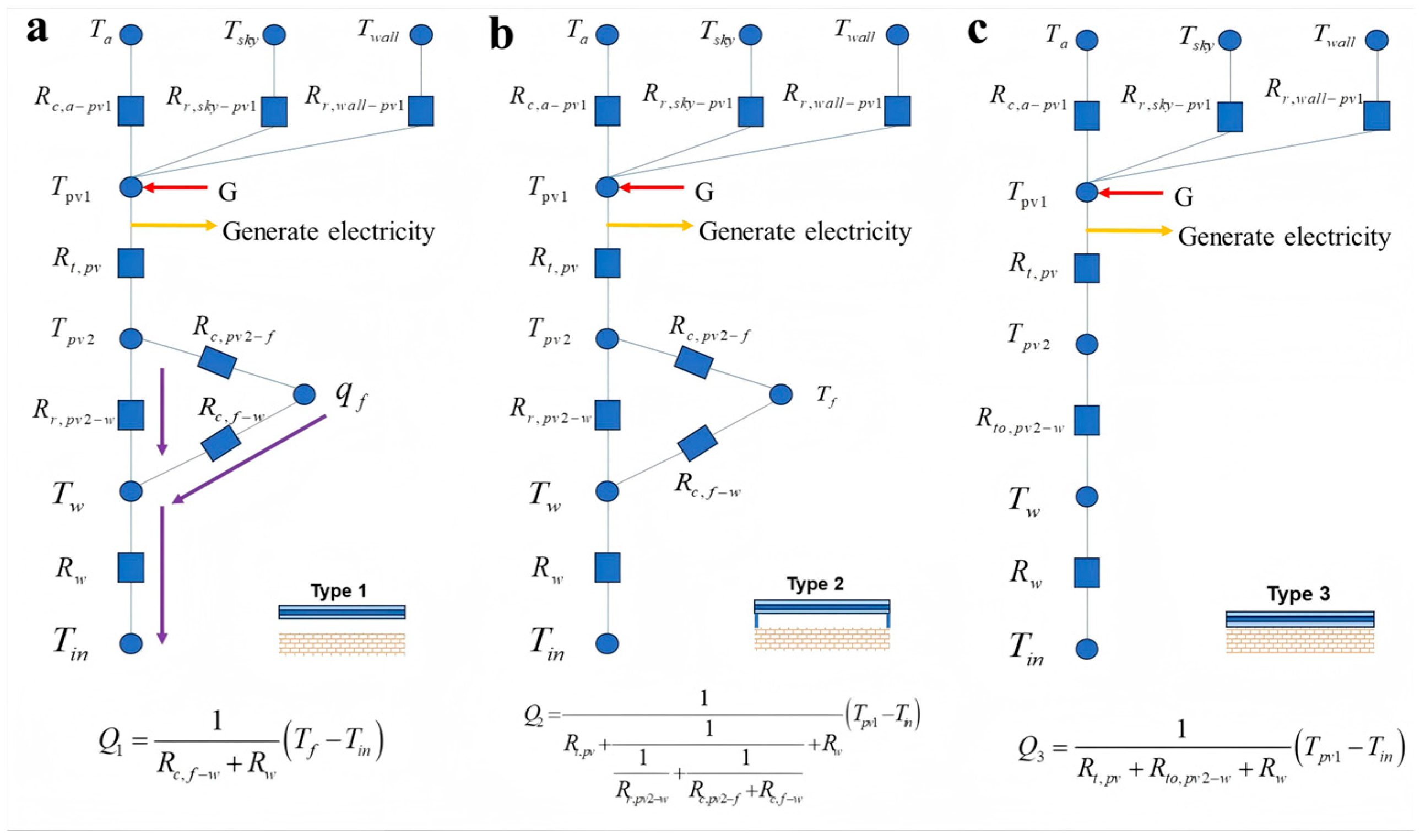
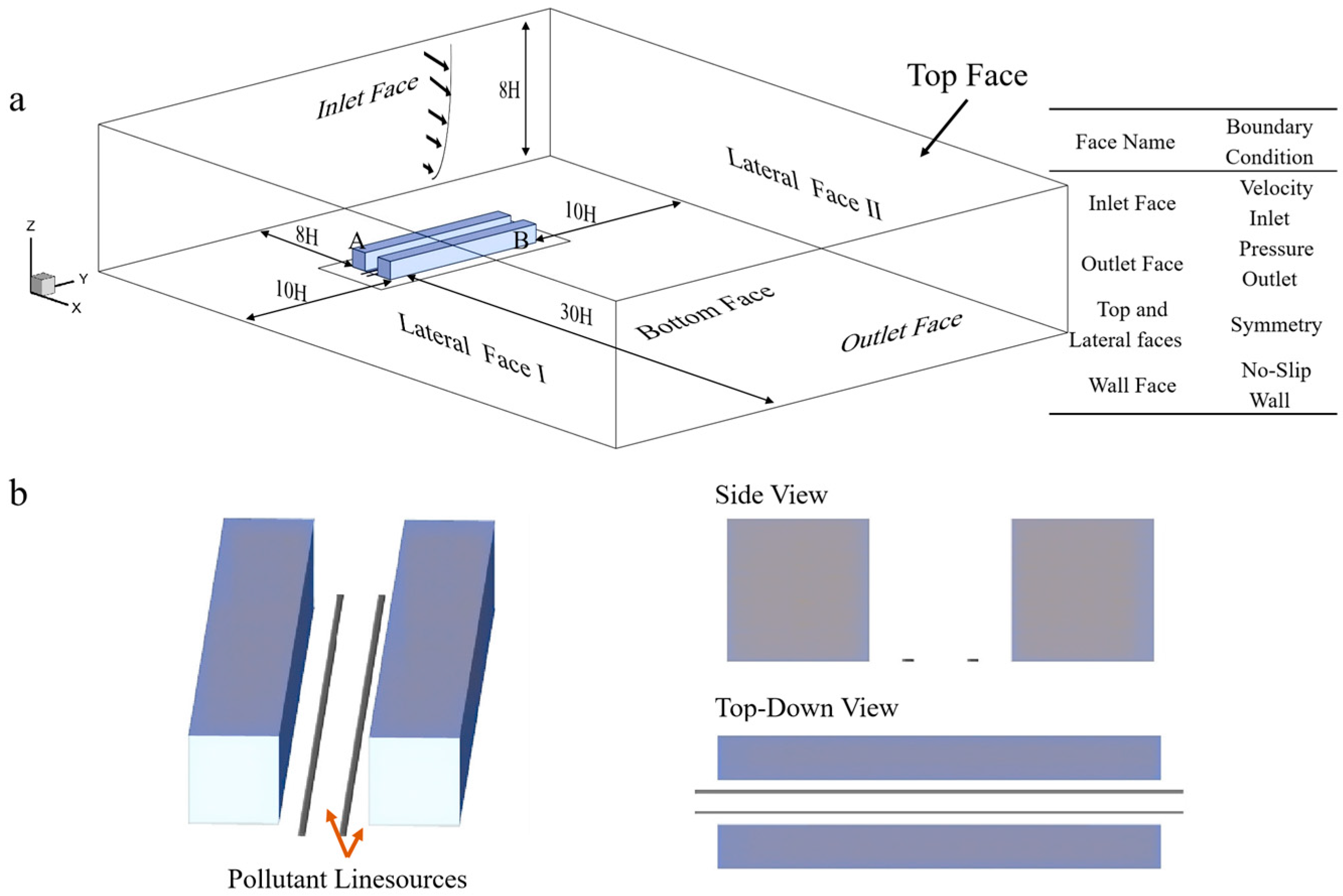
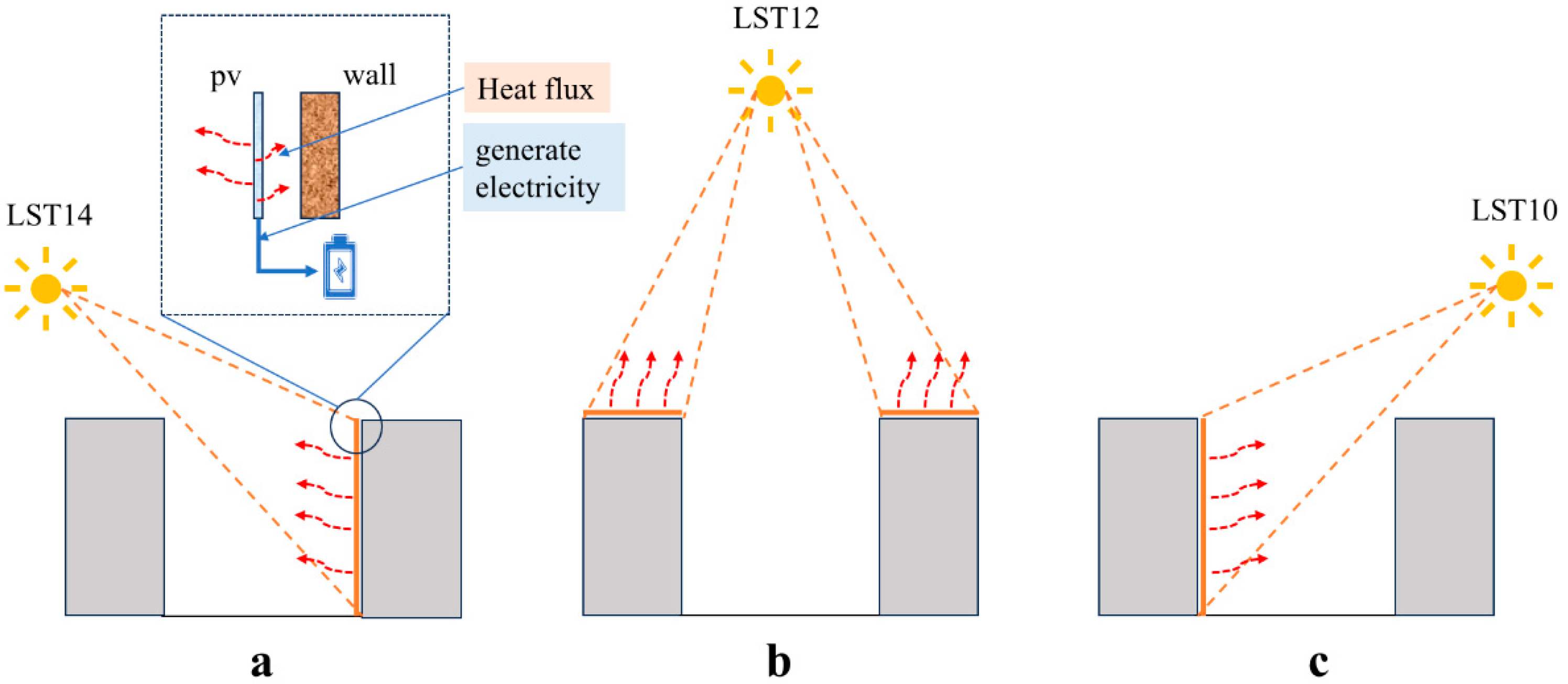
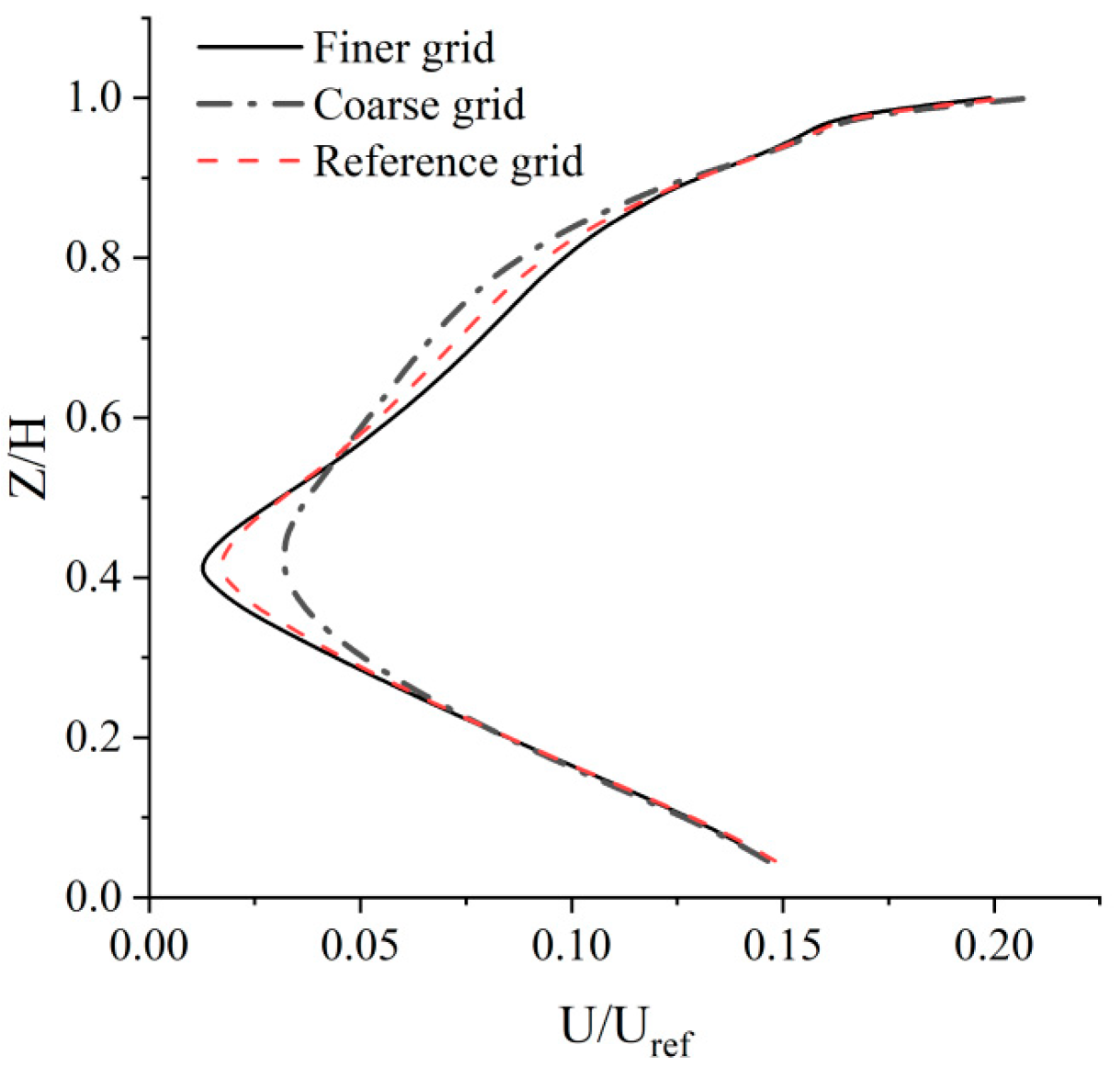
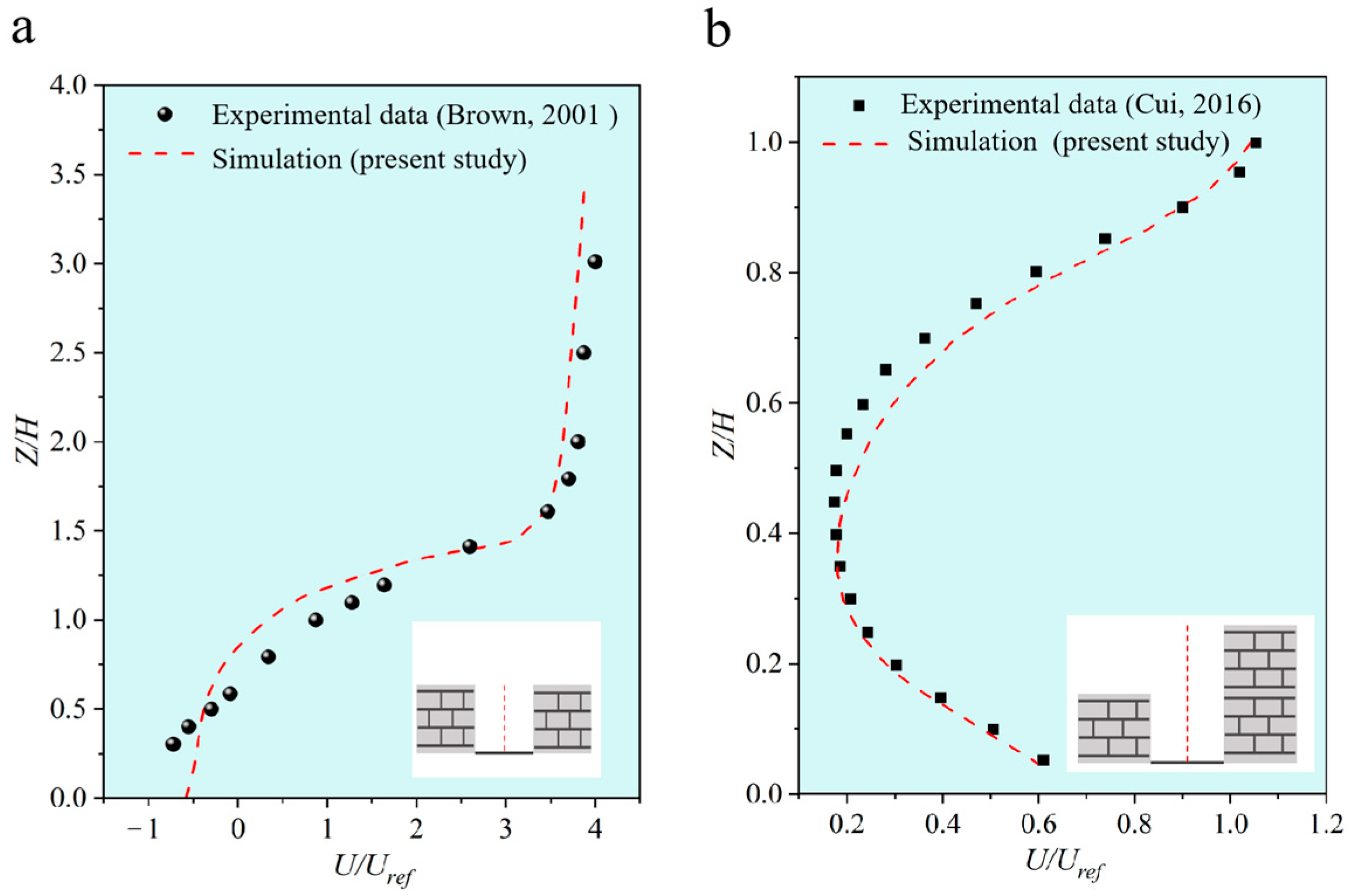


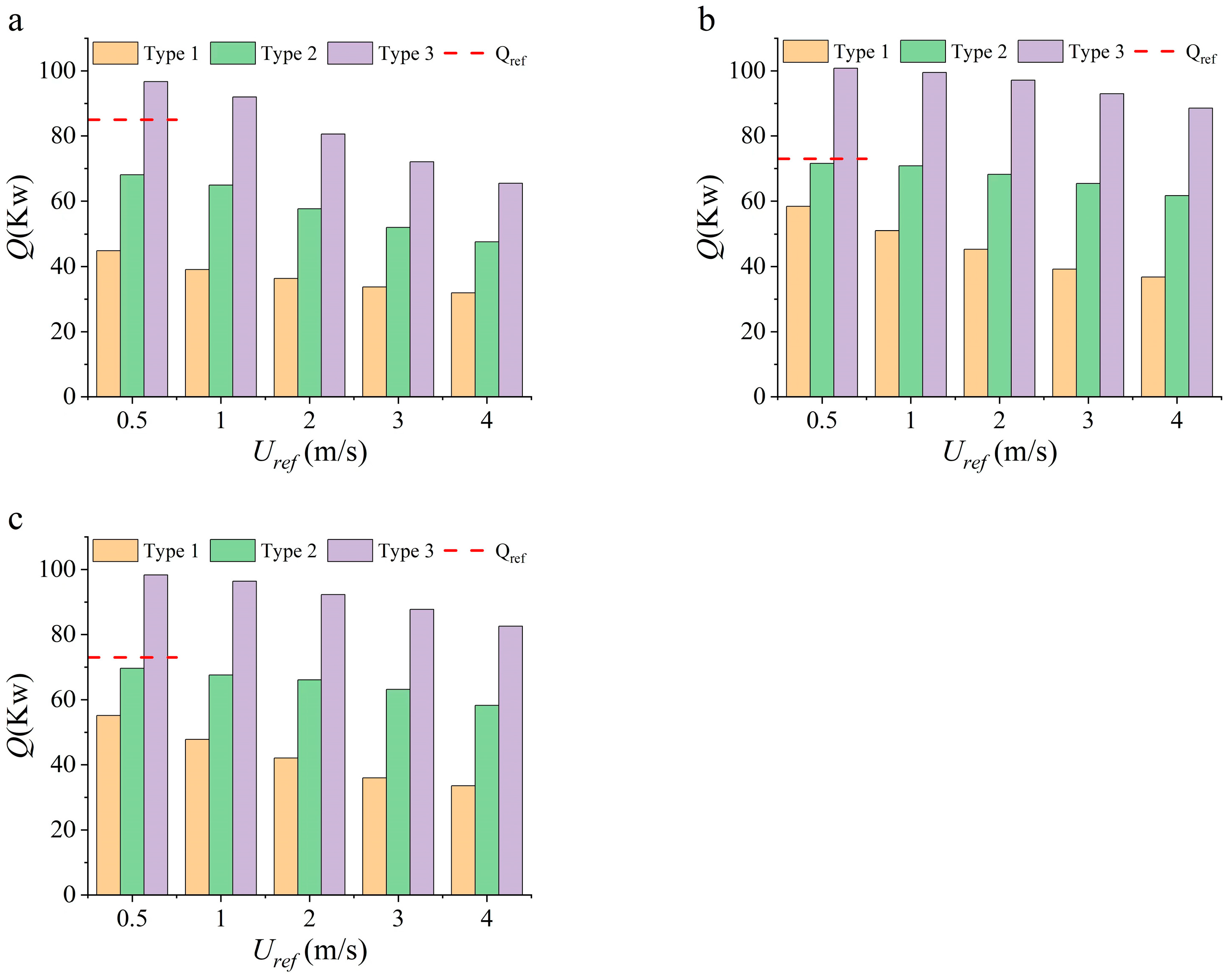
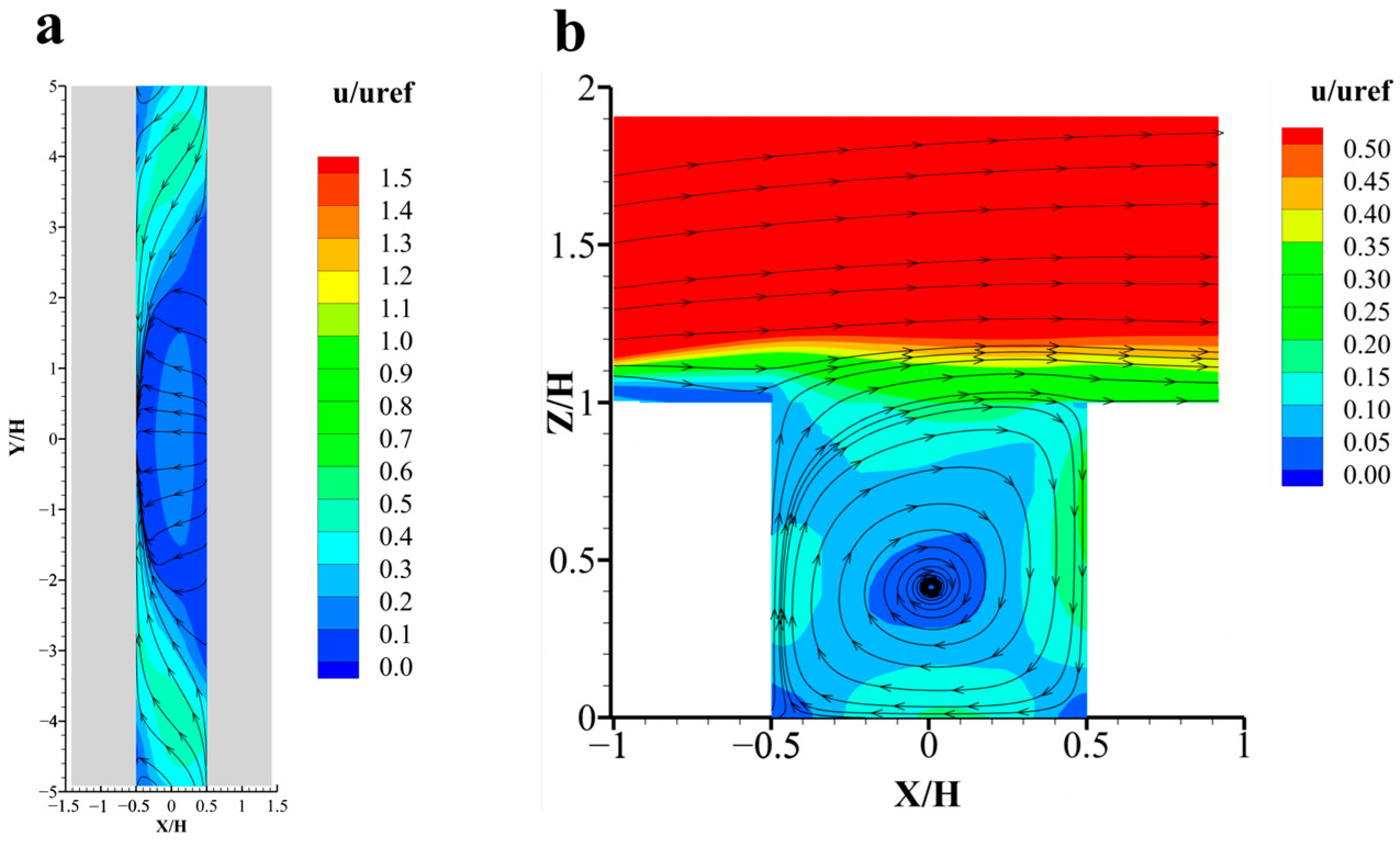
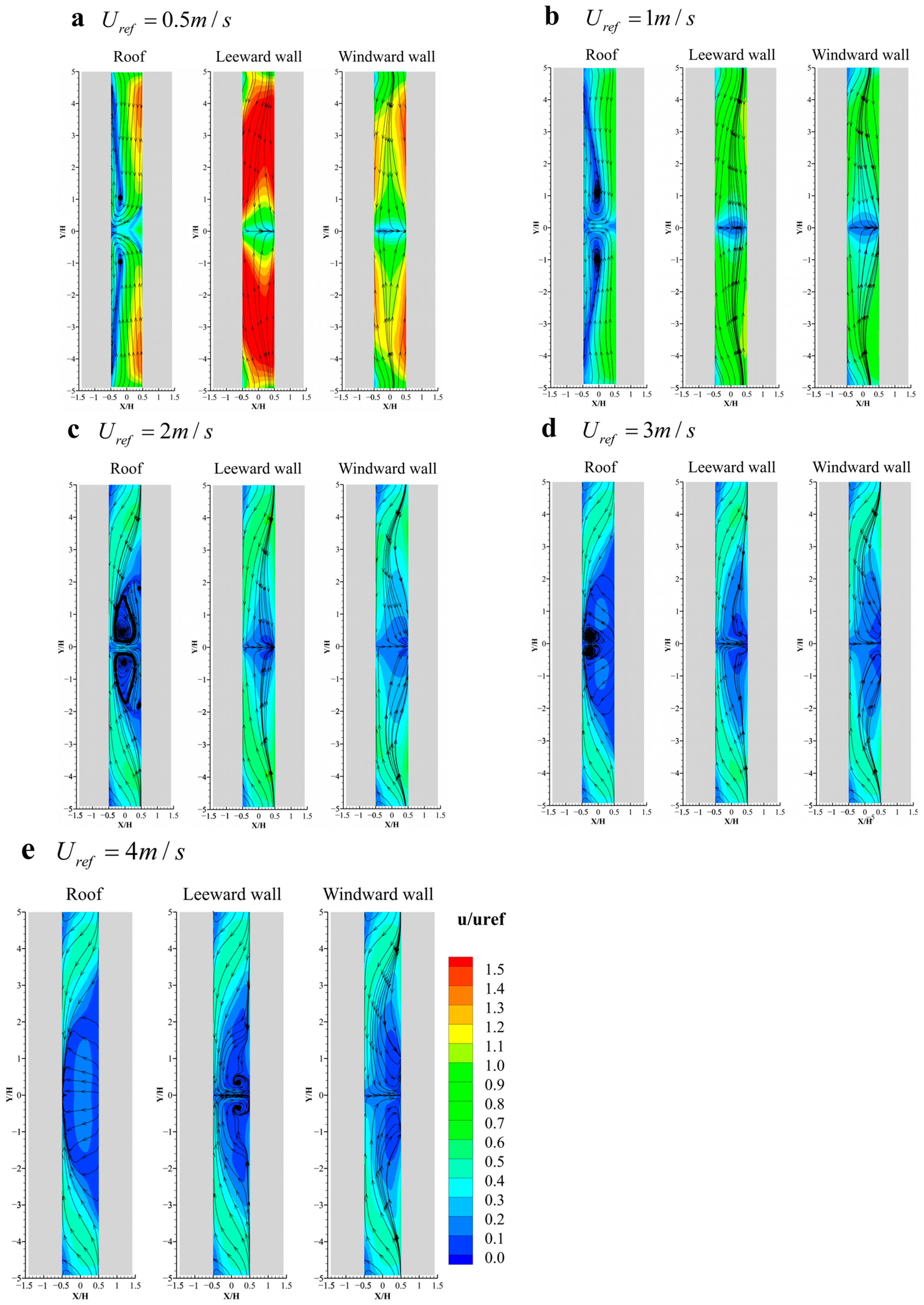
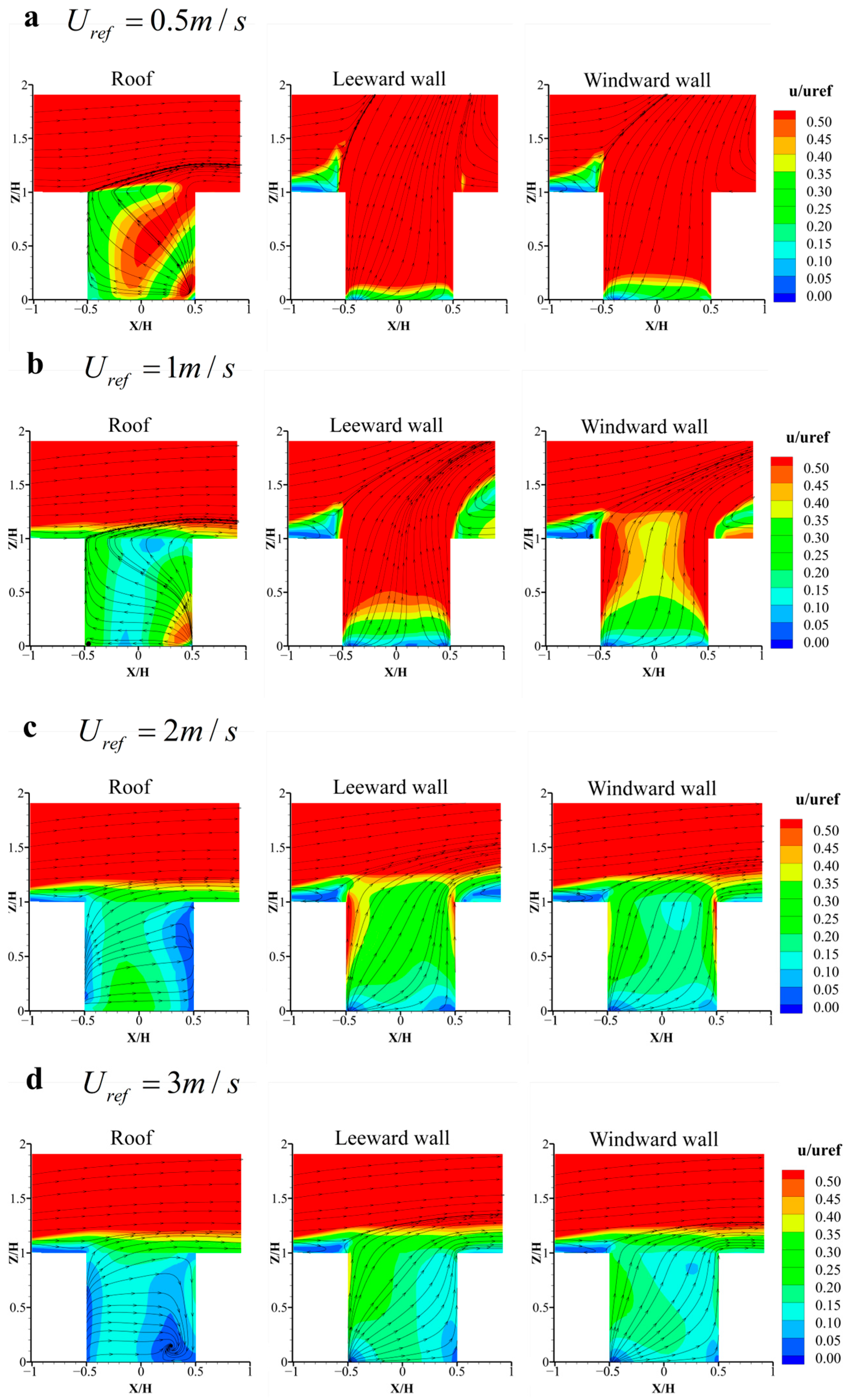


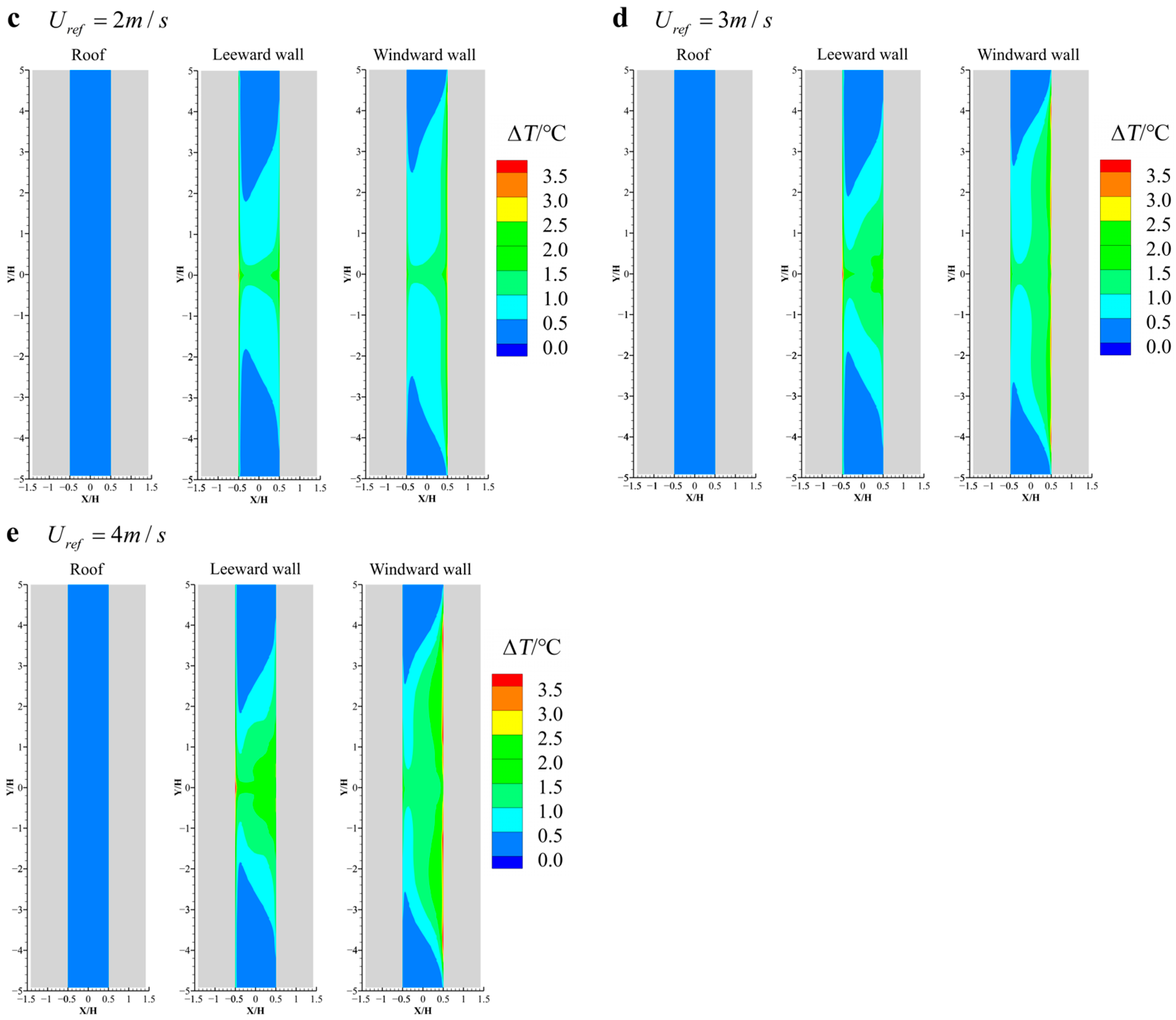

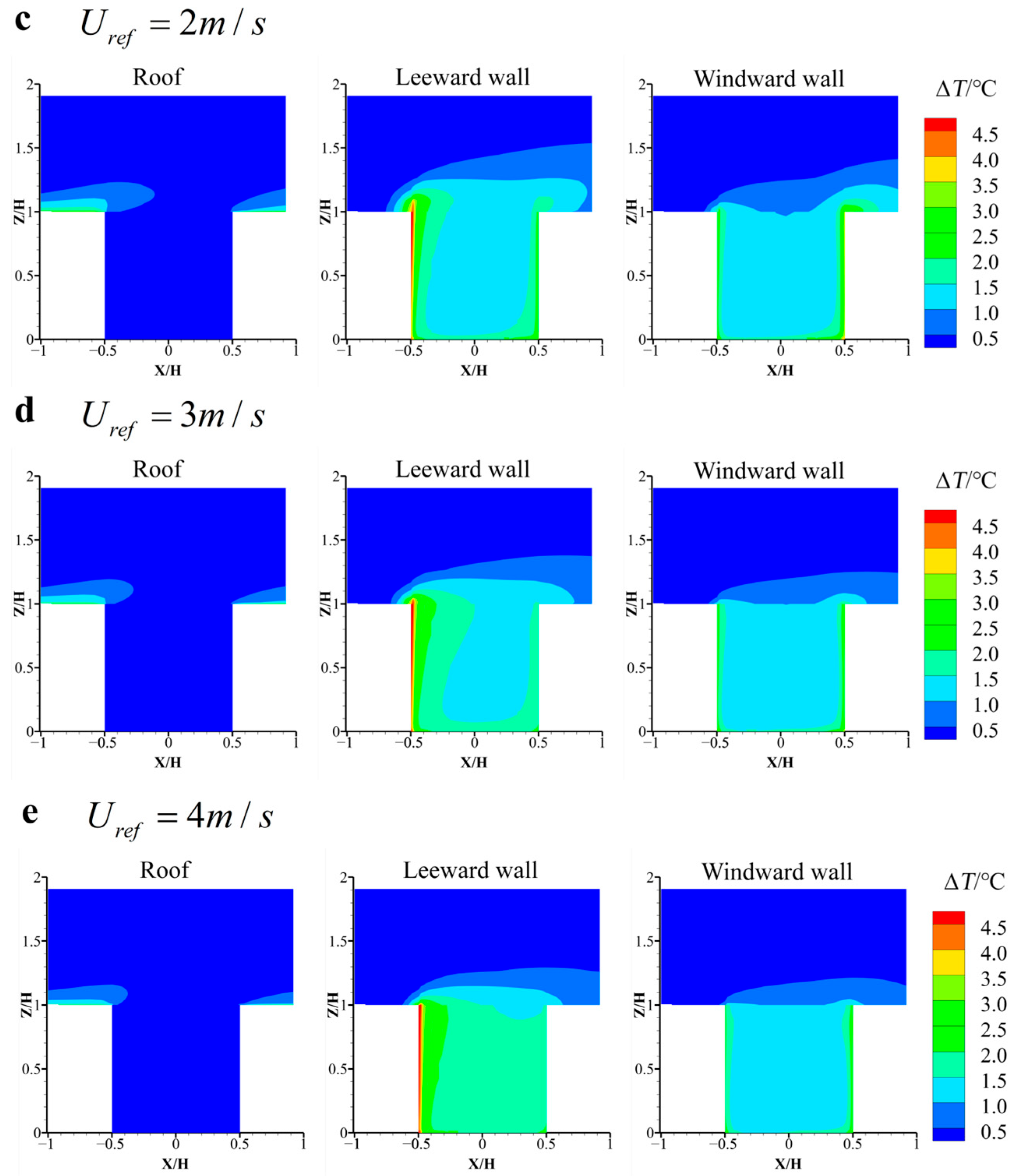
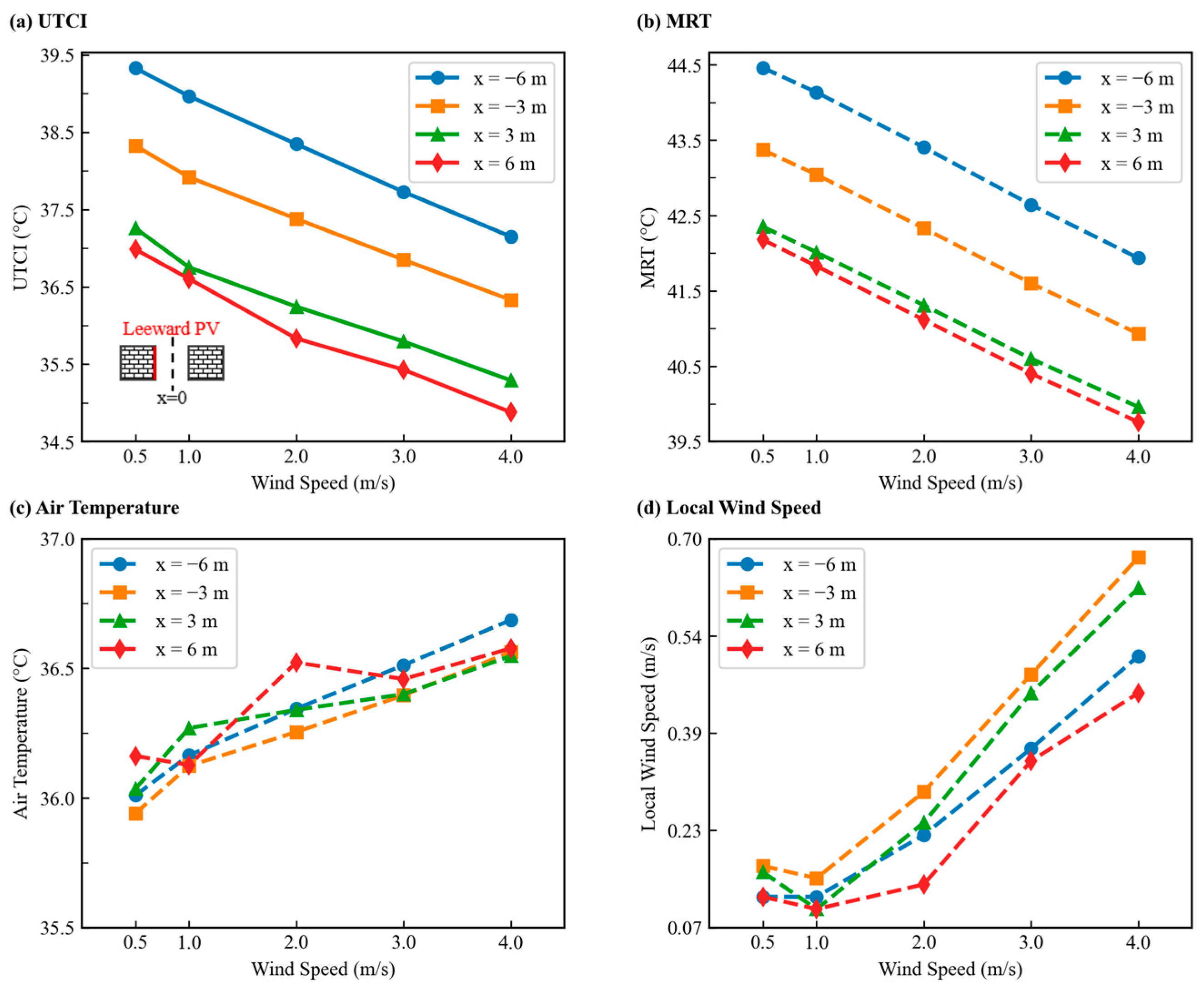
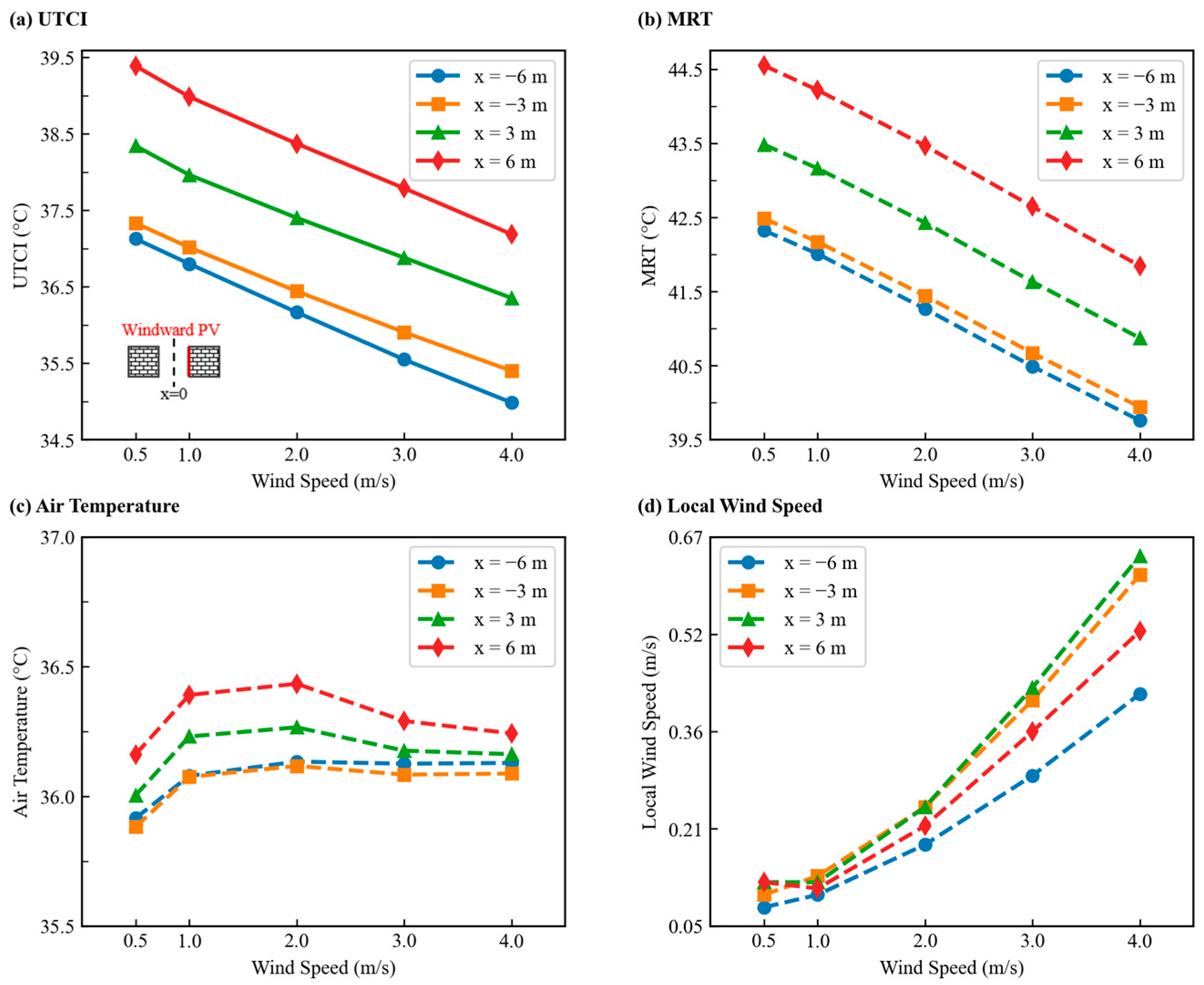
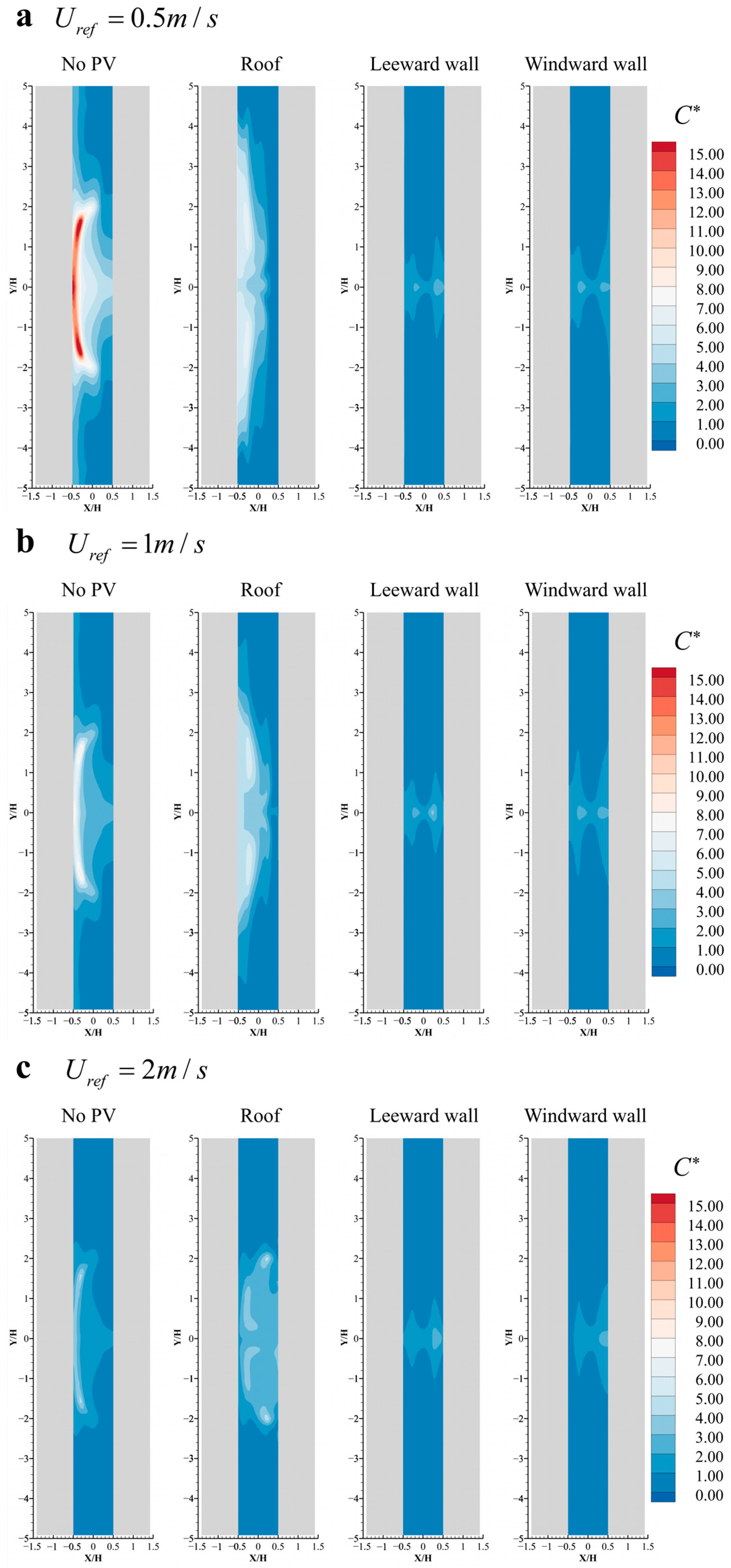
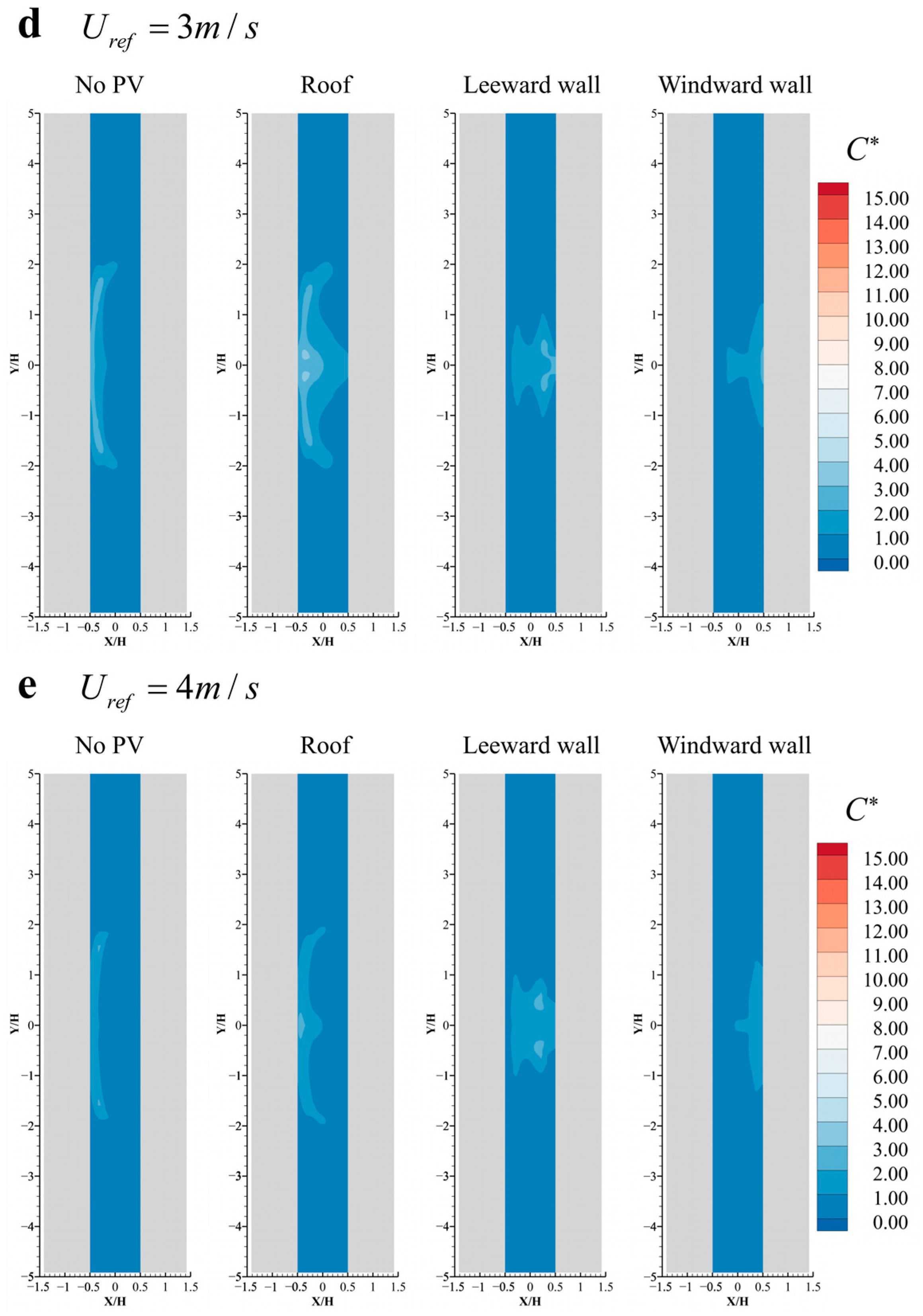



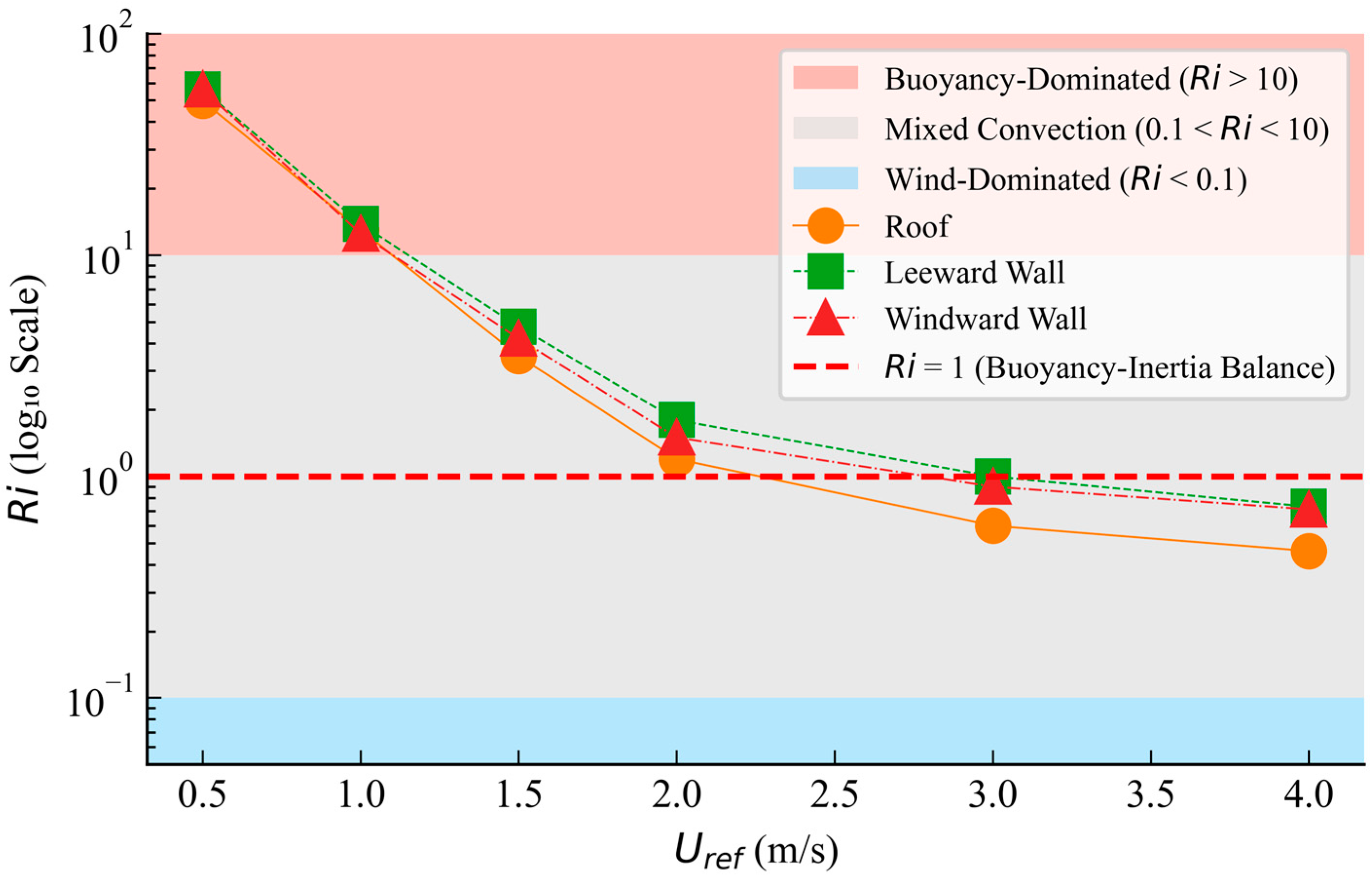
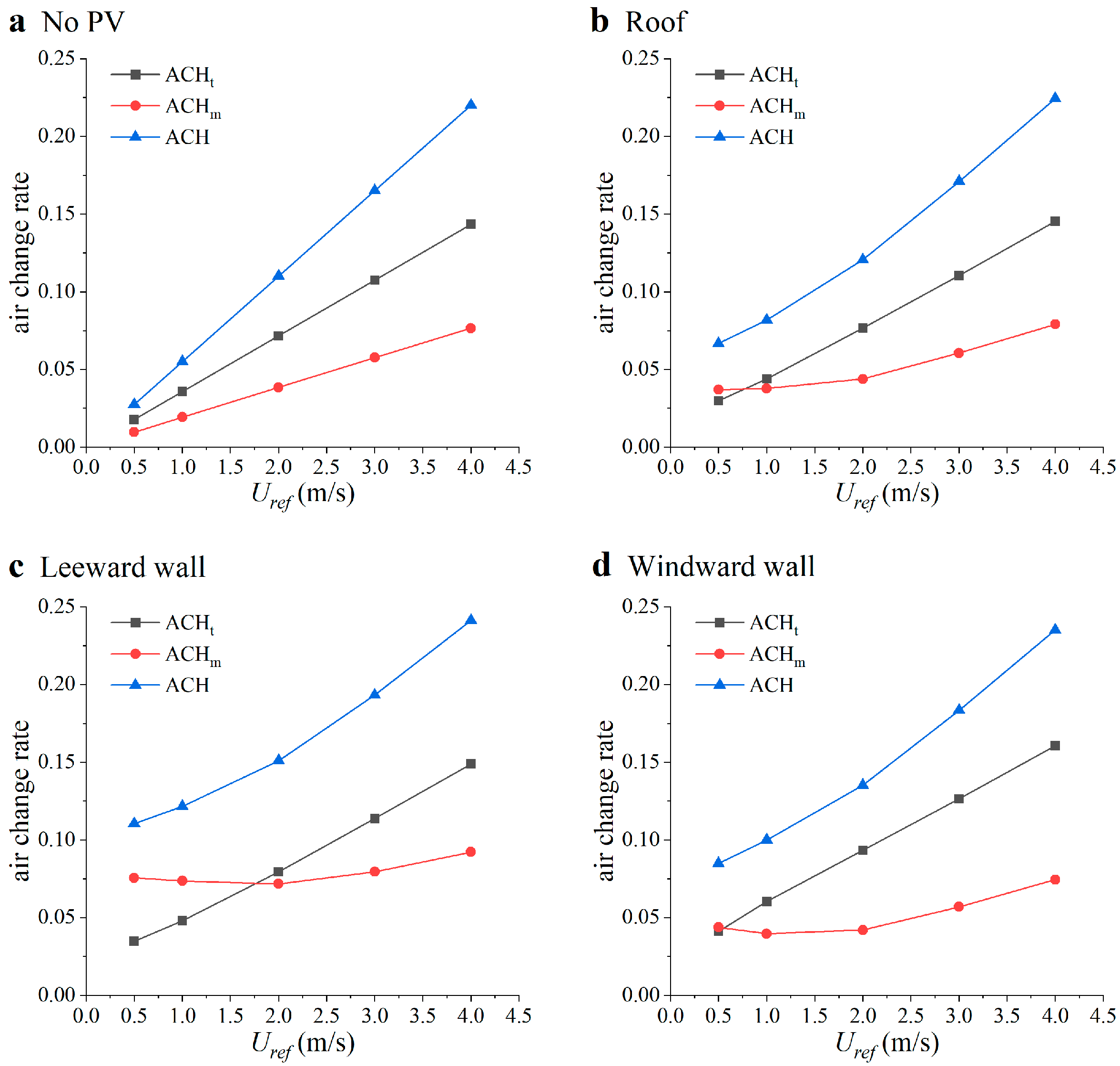
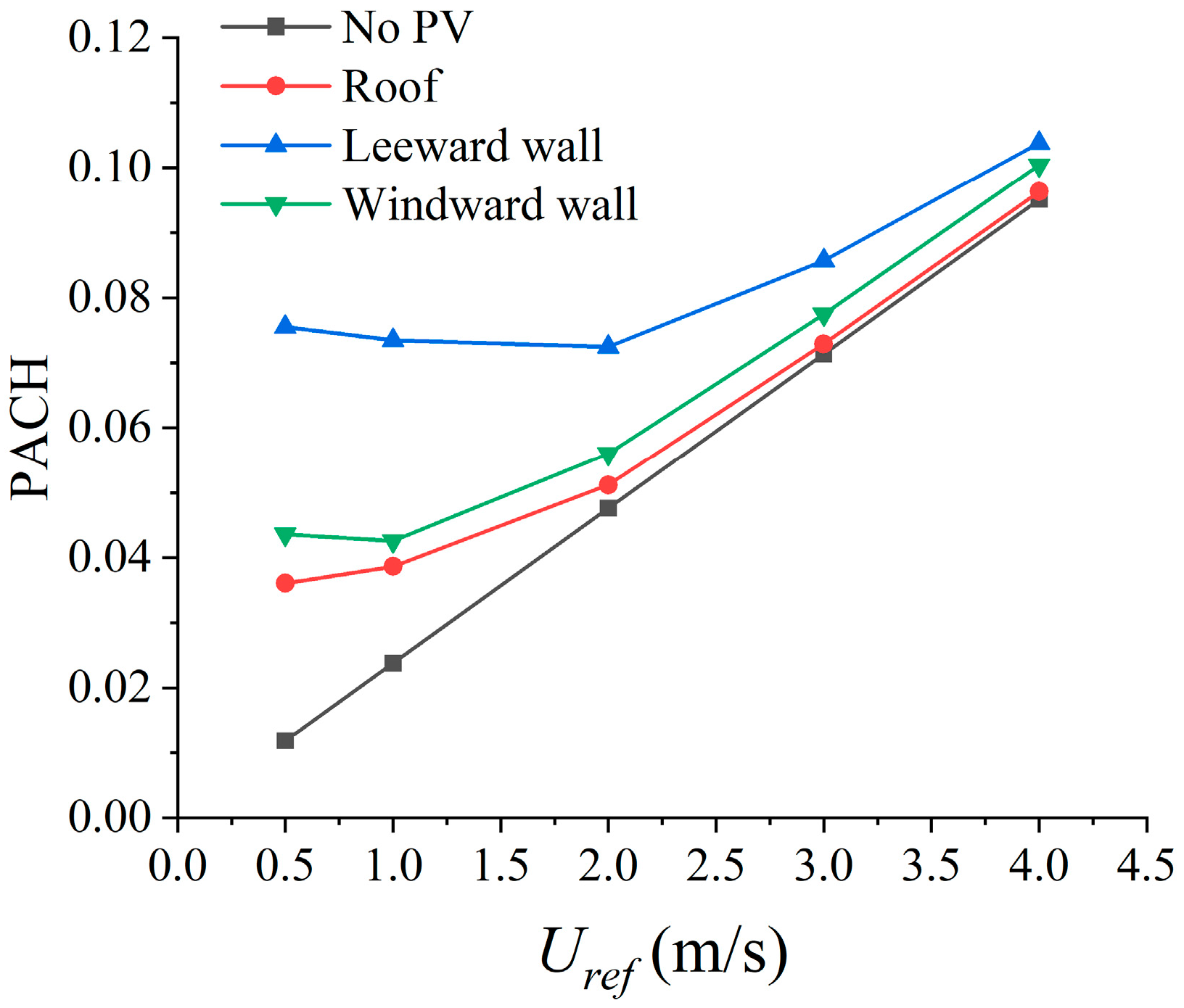
Disclaimer/Publisher’s Note: The statements, opinions and data contained in all publications are solely those of the individual author(s) and contributor(s) and not of MDPI and/or the editor(s). MDPI and/or the editor(s) disclaim responsibility for any injury to people or property resulting from any ideas, methods, instructions or products referred to in the content. |
© 2025 by the authors. Licensee MDPI, Basel, Switzerland. This article is an open access article distributed under the terms and conditions of the Creative Commons Attribution (CC BY) license (https://creativecommons.org/licenses/by/4.0/).
Share and Cite
Huang, M.; Chen, K.; Wang, F.; Liao, J. Numerical Simulation Study on the Energy Benefits and Environmental Impacts of BIPV Installation Configurations and Positions at the Street Canyon Scale. Buildings 2025, 15, 3692. https://doi.org/10.3390/buildings15203692
Huang M, Chen K, Wang F, Liao J. Numerical Simulation Study on the Energy Benefits and Environmental Impacts of BIPV Installation Configurations and Positions at the Street Canyon Scale. Buildings. 2025; 15(20):3692. https://doi.org/10.3390/buildings15203692
Chicago/Turabian StyleHuang, Minghua, Kuan Chen, Fangxiong Wang, and Junhui Liao. 2025. "Numerical Simulation Study on the Energy Benefits and Environmental Impacts of BIPV Installation Configurations and Positions at the Street Canyon Scale" Buildings 15, no. 20: 3692. https://doi.org/10.3390/buildings15203692
APA StyleHuang, M., Chen, K., Wang, F., & Liao, J. (2025). Numerical Simulation Study on the Energy Benefits and Environmental Impacts of BIPV Installation Configurations and Positions at the Street Canyon Scale. Buildings, 15(20), 3692. https://doi.org/10.3390/buildings15203692




